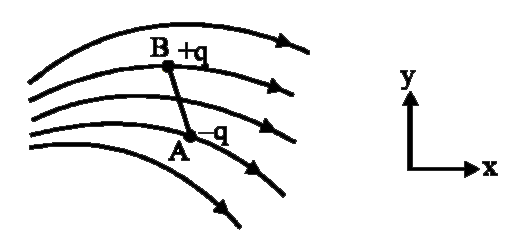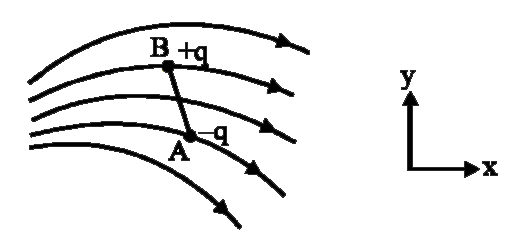An electric dipole is formed by two equal and opposite charges q with separation d. The charges have same mass m. It is kept in a uniform electric field E. If it is slightly rotated from its equilibrium orientation, then its angular frequency ω is:
√qE2md
√qEmd
√2qEmd
2√qEmd
The correct Answer is:C
To find the angular frequency ω of an electric dipole in a uniform electric field when it is slightly rotated from its equilibrium position, we can follow these steps:
Step 1: Understand the dipole moment
The electric dipole consists of two equal and opposite charges +q and −q separated by a distance d. The dipole moment p is given by:
p=q⋅d
Step 2: Torque on the dipole
When the dipole is placed in a uniform electric field E, the torque τ acting on the dipole is given by:
τ=p×E
For small angles θ, this can be approximated as:
τ≈pEsinθ≈pEθ
since sinθ≈θ for small θ.
Step 3: Relate torque to angular acceleration
The net torque is also related to the moment of inertia I and the angular acceleration α by:
τ=Iα
Thus, we can write:
Iα=pEθ
Step 4: Express angular acceleration
From the above equation, we can express angular acceleration α as:
α=pEIθ
Step 5: Relate to simple harmonic motion
The equation α=pEIθ resembles the form of simple harmonic motion, where:
α=−ω2θ
This implies:
ω2=pEI
Step 6: Substitute the dipole moment
Substituting p=qd into the equation gives:
ω2=qdEI
Step 7: Calculate the moment of inertia
For the dipole consisting of two masses m located at a distance d from the center, the moment of inertia I about the center of the dipole is:
I=2⋅(m⋅(d2)2)=2m⋅d24=md22
Step 8: Substitute moment of inertia into the equation
Substituting I into the equation for ω2:
ω2=qdEmd22=2qdEmd2
Step 9: Solve for angular frequency ω
Taking the square root gives:
ω=√2qdEmd2
Final Answer
Thus, the angular frequency ω of the dipole is:
ω=√2qemd
---
The electric dipole consists of two equal and opposite charges +q and −q separated by a distance d. The dipole moment p is given by:
p=q⋅d
When the dipole is placed in a uniform electric field E, the torque τ acting on the dipole is given by:
τ=p×E
For small angles θ, this can be approximated as:
τ≈pEsinθ≈pEθ
since sinθ≈θ for small θ.
The net torque is also related to the moment of inertia I and the angular acceleration α by:
τ=Iα
Thus, we can write:
Iα=pEθ
From the above equation, we can express angular acceleration α as:
α=pEIθ
The equation α=pEIθ resembles the form of simple harmonic motion, where:
α=−ω2θ
This implies:
ω2=pEI
Substituting p=qd into the equation gives:
ω2=qdEI
For the dipole consisting of two masses m located at a distance d from the center, the moment of inertia I about the center of the dipole is:
I=2⋅(m⋅(d2)2)=2m⋅d24=md22
Substituting I into the equation for ω2:
ω2=qdEmd22=2qdEmd2
Taking the square root gives:
ω=√2qdEmd2
Thus, the angular frequency ω of the dipole is:
ω=√2qemd
Similar Questions
An electric dipole (AB) consisting of two particles of equal and opposite charge and same mass is released in an electric field. In the figure field lines are without considering effect of field of dipole.

Angular acceleration of the dipole, immediately after it is released
View SolutionAn electric dipole (AB) consisting of two particles of equal and opposite charge and same mass is released in an electric field. In the figure field lines are without considering effect of field of dipole.

The centre of mass of the dipole
View Solution
Knowledge Check
An electron having charge 'e' and mass 'm' is moving a uniform electric field E. Its acceleration will be
Ae2mBE2emCeEmDmEeAn electric dipole has the magnitude of its charge as q and its dipole moment is p. It is placed in a uniform electric field E. If its dipole moment is along the direction of the field, the force on it and its potential energy are respectively
A2qE and minimum.BqЕ and pE.Czero and minimum.DqE and maximum.An electric dipole has the magnitude of its charge as q and its dipole moment is p. It is placed in a uniform electric field E. If its dipole moment is along the direction of the field, the force on it and its potential energy are respectively
A2q.E and minimumBq.E and p.ECZero and minimumDq.E and maximum
A protons of mass m charge 2 e is released from rest in a uniform electric field of strength E .The time taken by it to travel a distance d in the field is..
View SolutionAn electric dipole is situated in an electric field of uniform intensity E whose dipole moment is p and moment of inertia is I. If the dipole is displaced slightly from the equilibrium position, then the angular frequency of its oscilliations is
View SolutionAn electric dipole is situated in an electric field of uniform intensity E whose dipole moment is p and moment of inertia E whose dipole moment is p and moment of inertia is I. If the dipole is displaced slightly from the equilibrium position, then the angular frequency of its oscillations is :
View SolutionAn electric dipole is situated in an electric field of uniform intensity E whose dipole moment is p and moment of inertia E whose dipole moment is p and moment of inertia is I. If the dipole is displaced slightly from the equilibrium position, then the angular frequency of its oscillations is :
View SolutionIf a simple pendulum has charge q and is oscillating in a uniform electric field E in the direction of acceleration due to gravity, then its frequency of oscillations
View Solution
